|
Journals: Week 8 (June 4-10, 2007)
[weeks 1-10]
[weeks 11-20]
week 1 | week 2 | week 3 | week 4 | week 5 | week 6 | week 7 | week 8 | week 9 | week 10
DAY 52: Wednesday, June 6, 2007
(Alamosa, CO)
A few weeks ago, when we were volunteering in Greensburg, Kansas, we met a Presbyterian
minister named Skip who was working on clearing the lot next to the one we were working
on. We struck up a conversation with Skip, and he mentioned to us that if we were
ever in Alamosa, Colorado (on the southern border of Colorado, just above New Mexico) that
we should look up a fella named Brian at a great place to volunteer called La Puente Home. Skip explained that La Puente is
a huge non-profit organization/community and includes a homeless shelter, soup kitchen,
thrift shop, free clothing 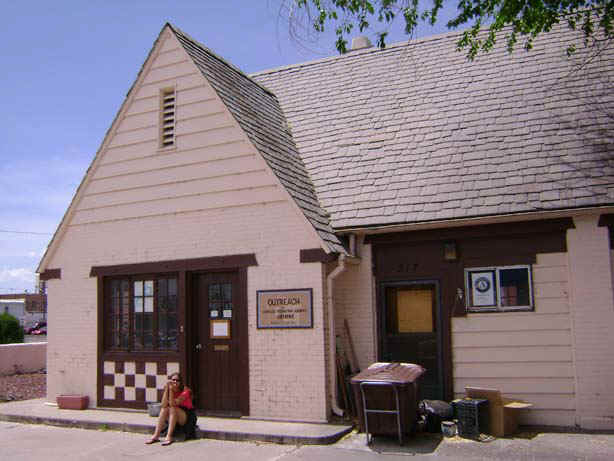 store, boutique and antique store, outreach center, bookstore,
motel, food bank, and coffee shop- all of which benefit those in need in Alamosa.
Upon leaving Denver and heading south toward Santa Fe, NM, Jonathan and I decided to check
it out. We planned to arrive on Monday and hopefully hook up with Brian, who might
be able to give us some volunteer work and recommend an inexpensive place to stay. store, boutique and antique store, outreach center, bookstore,
motel, food bank, and coffee shop- all of which benefit those in need in Alamosa.
Upon leaving Denver and heading south toward Santa Fe, NM, Jonathan and I decided to check
it out. We planned to arrive on Monday and hopefully hook up with Brian, who might
be able to give us some volunteer work and recommend an inexpensive place to stay.
On our first evening in Alamosa (we got here about 7 pm), we were unsuccessful in
connecting with Brian, playing a bit of phone tag. We ended up having to stay the
night in Monte Vista, the next town over (about 20 miles northwest of Alamosa) due to a
firemen's convention in Alamosa, which rendered all the hotels/motels in Alamosa
completely booked. We couldn't camp either (to Jonathan's great dismay- uh, sarcasm)
due to thunderstorm showers, so we spent a quiet evening in Monte Vista at the local
historic inn. The next day we headed to La Puente and hoped to find Brian and get to
work.
On our way back into town, we finally got Brian on the phone and headed to the outreach
center. He said there was no need for volunteer help at the shelter that day, but
there was a volunteer opportunity at "ReThreads," a small, free clothing store a
few blocks from the outreach office. Here we met Josephine, the volunteer manager of
the store. Josephine has been with La Puente for about a year and a half and has
almost completed her volunteer commitment through AmeriCorps. She was eager to have
some extra hands to help sort through the many bags of donated clothing, which were then
hung and displayed on the racks. Josephine usually sorts and hangs the clothing and
other various odds and ends herself, while she simultaneously helps customers looking for
clothes for their families, and also compiles statistics for the store. ReThreads is
set up like a thrift shop, but all the clothes are completely free. Families can
come in once a month and have three pairs of men's and women's pants, two men's and
women's shirts, labor clothes (there are many Mexican immigrant workers here who harvest
potatoes), professional clothes, and infants/children's clothes.
Josephine told us all about La Puente's many programs, and suggested we have a meal at the
shelter and visit some of the other programs. 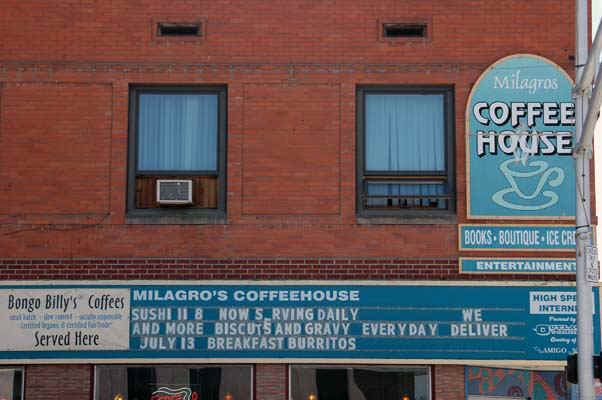 She also mentioned
that she is an artist (mainly she does colored pencil drawings and makes note cards), and
told us we could find some of her work at the local coffee shop, Milagros, as well as at
the local book store. We met a few other La Puente volunteers and staff who happened
to stop into ReThreads while we were there, all of them very excited to have the two of us
in town to help out, and all of them were willing to give us tours of their various
programs, draw us maps of the town, give us their phone numbers, and even offer us a free
place to stay for the night! Jeez, these folks are SO NICE!!!!! We made plans
to stay at La Puente's motel, the Sky Vue (for a pretty great rate) and told Becky
(another La Puente volunteer) that we would meet her group the following day to do some
planting and weeding at the community garden. She also mentioned
that she is an artist (mainly she does colored pencil drawings and makes note cards), and
told us we could find some of her work at the local coffee shop, Milagros, as well as at
the local book store. We met a few other La Puente volunteers and staff who happened
to stop into ReThreads while we were there, all of them very excited to have the two of us
in town to help out, and all of them were willing to give us tours of their various
programs, draw us maps of the town, give us their phone numbers, and even offer us a free
place to stay for the night! Jeez, these folks are SO NICE!!!!! We made plans
to stay at La Puente's motel, the Sky Vue (for a pretty great rate) and told Becky
(another La Puente volunteer) that we would meet her group the following day to do some
planting and weeding at the community garden.
When we woke up this morning, we were quite surprised by the voracious 60 mph winds
blowing outside (good thing we didn't camp!!). Not really knowing what exactly was
going on, we decided to forgo the gardening (we hadn't slept very well anyway). As
it turns out, these winds are common this time of year, and can last for several
days. (Apparently, they have contributed to creating the sand dunes which make this
area famous. The Great Sand Dunes National Park is about 30 miles from here.)
The winds lasted all day and blew leaves and branches right off the trees. It also
whipped the sand into our eyes and made going outside not much fun at all! As it
turns out, Becky and her group did not go gardening this morning (this made us feel a lot
better about sleeping in!).
We stopped into Milagros for breakfast to check email and update the website. Here,
we found some of Josephine's artwork- two beautiful rose drawings as well as two Sand Hill
Crane drawings. They were really marvelous, and were a great source of encouragement
to me to continue working on my own colored pencil drawings. We also ventured across
the street to the local book store to find some of Josephine's note cards, 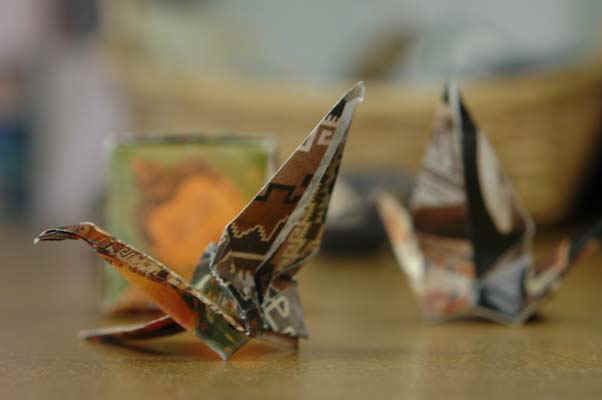 but were
unsuccessful. So we decided to take a little driving tour around town, and found the
shelter/soup kitchen as well as the community garden. After our detour, it was time
to go back to Re-threads to do some more volunteer work. but were
unsuccessful. So we decided to take a little driving tour around town, and found the
shelter/soup kitchen as well as the community garden. After our detour, it was time
to go back to Re-threads to do some more volunteer work.
We got to ReThreads around 1:00, and hung out chatting with Josephine. She told us
more about her artwork and showed us some of her note cards (cut out silhouettes of cranes
on colored card stock), which we purchased. I mentioned that I really admired a
small tree on her desk with many Origami cranes hanging from it. When I asked, she
graciously agreed to show Jonathan and I how to make these cranes in between greeting
customers.
Josephine told us that these cranes are a symbol of peace, particularly in protest against
nuclear weapons. She relayed the story about a Japanese girl named Sadako who was a
victim of the bombing in Hiroshima- she was diagnosed with leukemia (the "atom bomb
disease) at age 11 (in 1955). She had heard of an ancient legend that said if you
make 1,000 cranes, your greatest wish will come true. Sadako's wish was to live, so
she began making paper cranes. She made over 1,000 cranes but died at the age of
12. (For the full story, including other information about peace projects and
instructions on how to make origami cranes, click on Sadako's Story.) This story led to
a discussion about nuclear warfare and politics, and as it turns out Josephine is pretty
active in working for social justice causes. She told us about the "Catholic
Worker" movement, and a video called "Conviction", which depicts the story
of three nuns who were convicted to three years in prison for a symbolic protest against a
nuclear missile plant in eastern Colorado. Jonathan and I watched the video this
evening- pretty intense, but very interesting. I would recommend it to anyone
interested in non-violent, peaceful demonstrations against government crime.
After doing some more volunteer work at ReThreads, we visited the local thrift and antique
shop. Then we headed to the shelter for dinner. We ate vegetarian chili, corn
bread, watermelon, salad and cake prepared by a Presbyterian group from Illinois.
Then we were given a tour by Rachel, a volunteer/staff person at the shelter. She
gave us a tour of the home, showing us where the men and women lived, and told us some
more about the programs. She also told us about how the issue of illegal immigration
has been affecting the lives of the homeless people in the shelter, many of whom come up
from Mexico to work harvesting crops to help feed and support their families.
Fortunately, the shelter is considered a refuge for these people, and the staff are not
required to "out" their residents. However, it seems this issue is a
multi-faceted one and quite complex. Whereas the strict regulations often punish the
illegal workers through deportation, it also forces employers to provide fair wages and
working conditions for legal workers- so they cannot be taken advantage of.
Something tells me though, that legal and illegal workers are still paid only a fraction
of what they deserve. No matter which side of this controversial argument you happen
to be on, remember to be grateful for your fruit and vegetables when you eat them- and to
be reminded about who is planting and harvesting them.
Tomorrow, Jonathan and I plan to get out to see the sand dunes. We will head back to
the shelter at 2 to help make dinner for the evening, and then stop by a local pub for a
Habitat for Humanity benefit concert (starring Rachel, our shelter tour guide who sings
and plays the guitar). Should be another great day discovering America! ~E
back to top
|
DAY 54: Friday, June 8, 2007 (Alamosa,
CO)
We had sand for lunch today. Well, sort of. Yesterday, we did go to the Great
Sand Dunes National Park & Preserve;  however, we did not climb the dunes. Actually,
before we made it to the dunes yesterday, we saw a sign for Zapata Falls, which turns out
to be up in the Sangre De Cristo Mountain, about a three-mile drive on a dirt and rocky
road, and then a half-mile walk further up the mountain. Whether it's because I'm
slightly out of shape (and I'm being generous to myself!), or the altitude of where we're
at (approximately 8,000 feet above sea level), but simple breathing has become
not-so-simple anymore, even when we're not doing anything strenuous. Suffice it to
say that the ordinarily not-so-strenuous half-mile hike up to Zapata Falls required many
breaks to simply catch our breath. When we got to the falls, we didn't see any
falls. What we saw was a picture of the falls, a huge rock that looked like where
the falls would normally be falling (based on the picture), and a small running
stream. Not knowing what to expect, we assumed that the falls were no more, that the
glacier from which the falls emanated simply dried up over time. However, when we
returned to town, Josephine said we probably didn't walk far enough up the stream to see
the actual falls. Oh well. Next time! however, we did not climb the dunes. Actually,
before we made it to the dunes yesterday, we saw a sign for Zapata Falls, which turns out
to be up in the Sangre De Cristo Mountain, about a three-mile drive on a dirt and rocky
road, and then a half-mile walk further up the mountain. Whether it's because I'm
slightly out of shape (and I'm being generous to myself!), or the altitude of where we're
at (approximately 8,000 feet above sea level), but simple breathing has become
not-so-simple anymore, even when we're not doing anything strenuous. Suffice it to
say that the ordinarily not-so-strenuous half-mile hike up to Zapata Falls required many
breaks to simply catch our breath. When we got to the falls, we didn't see any
falls. What we saw was a picture of the falls, a huge rock that looked like where
the falls would normally be falling (based on the picture), and a small running
stream. Not knowing what to expect, we assumed that the falls were no more, that the
glacier from which the falls emanated simply dried up over time. However, when we
returned to town, Josephine said we probably didn't walk far enough up the stream to see
the actual falls. Oh well. Next time!
After the Zapata Falls debacle, we drove to the Great Sand Dunes National Park, which is
about 30 miles northeast of where we are staying in Alamosa, and just a few miles up from
Zapata Falls. It's really interesting that out in the middle of nowhere there are
these enormous sand dunes just sitting there in front of the Sangre De Cristo
Mountains. We stopped by the Visitor Center (which we found out is 8,175 feet above
sea level) where we were informed we could walk to the top of the dunes, and that it takes
about an hour and a half to walk up, and about a half hour back. Looking out of the
window of the visitor center, we noticed small dots peppered throughout 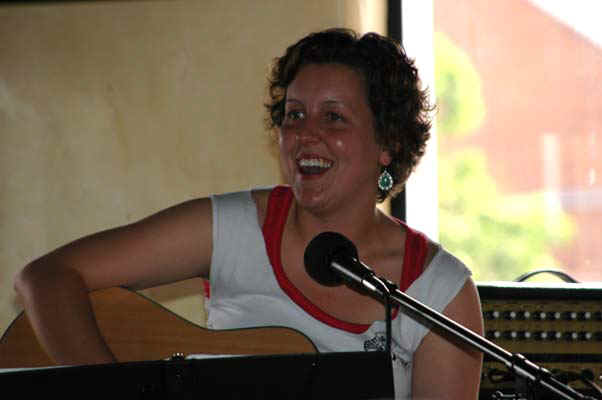 the dunes.
Turns out those dots were actually people climbing the dunes. The ranger informed us
that there was relatively no risk in climbing to the top, despite my seeing many apparent
risks as the dunes' edges looked quite sharp in some areas. Since we didn't have the
time to attempt the climb yesterday (we wanted to get back to see Rachel, the volunteer we
met two nights ago at the shelter, who was singing at a benefit for Habitat For Humanity
at 4:00), we decided we would come back early the next day (today) and climb the dunes
before heading out to Taos, New Mexico, our next intended destination. the dunes.
Turns out those dots were actually people climbing the dunes. The ranger informed us
that there was relatively no risk in climbing to the top, despite my seeing many apparent
risks as the dunes' edges looked quite sharp in some areas. Since we didn't have the
time to attempt the climb yesterday (we wanted to get back to see Rachel, the volunteer we
met two nights ago at the shelter, who was singing at a benefit for Habitat For Humanity
at 4:00), we decided we would come back early the next day (today) and climb the dunes
before heading out to Taos, New Mexico, our next intended destination.
We did get back in time to see Rachel sing with two other female volunteers - they call
themselves LuLu - at the San Luis Valley Brewing Company. Though it was slightly
hard to hear, either due to the ensuing conversations of the crowd or the sound system
being used, we could hear well enough to know that Rachel has some definite talent, not
only donning a beautiful singing voice, but also playing the guitar and keyboard.
Rachel, who is originally from the east coast (D.C., if I remember correctly), will be
leaving Alamosa in a month or so as her volunteer assignment is up. After a brief
rest back on the east coast, she will be heading out to India for a year to teach at an
international school. Now this is an adventurer! Good luck to you,
Rachel, and thank you for the special attention.
One of the reasons we were going to be heading out today was that the motel we're staying
at did not have rooms available for the weekly rate. Though we're getting a nicely
reduced daily rate, Rob, the motel manager, said we could only stay three nights at this
rate. (Rob is a one-man-show here at the Sky Vue Motel, owned by the non-profit La
Puente Home - he is the manager, the cleaning crew, the handy-man, the landscaper, and
plenty more I'm sure.) When we got back to the motel last night, Rob was nice enough
to ask us if we wanted to stay another night at the reduced rate. Since we wanted to
climb th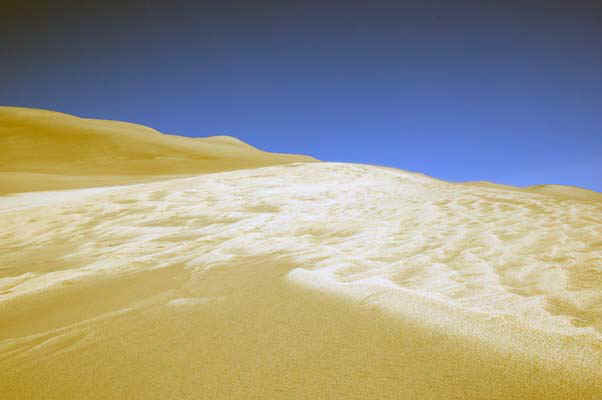 e dunes the next day, we thought it might serve us well to stay one more
night, recoup from the climb up the dunes, then head out to New Mexico on Saturday,
refreshed and ready for more adventure. So we decided to take Rob up on his offer. e dunes the next day, we thought it might serve us well to stay one more
night, recoup from the climb up the dunes, then head out to New Mexico on Saturday,
refreshed and ready for more adventure. So we decided to take Rob up on his offer.
So back to our sand-filled lunch today. After our morning stint at Milagros for
breakfast and wireless internet, we headed back to the dunes. We were in time for
the 10:30 nature walk given by one of the park rangers, explaining how the dunes were
formed and other facts about the dunes (like not only are there kangaroo rats and coyotes
in the area, but also mountain lions and prong-horned antelopes, the second-fastest animal
alive at 60mph, second only to the cheetah). Since you asked, here are some
additional facts about the dunes, taken from the map given to us upon entering the park:
The sand from the dunes originate mostly from the San Juan Mountains, more than 65 miles
to the west. Wind and water are the primary movers of the grain. Streams,
creeks, melting snow, and flash floods brought bits of rock out of the mountains to the
valley floor. Southwesterly winds then began the slow process of bouncing the grains
toward the low curve of the Sangre De Cristo Mountains. There, they piled up at the
base of the mountains or dropped into creeks to be washed back out toward the valley
floor. The age estimates range from 12,000 years to more than a million years.
Research is ongoing. At least two factors are responsible for the dunes being so
tall: Huge quantities of sand are carried downstream by Medano Creek, then redeposited by
the southeasterly winds on the eastern edge of the dunefield, accounting for the very tall
dunes in that area. Also, less common by stronger winds blow from the
northeast. These northeasterlies blast through the passes and pile the dunes back
onto themselves, producing startlingly crisp ridges- and the tallest dunes in North
America. (Aren't you glad you asked?!)
After the 40 minute nature walk, Elena and I headed up the dunes. The winds were
blowing at a good clip, though not as treacherously as the 60mph winds just two days
ago. The temp was about 60 degrees, but there were practically no clouds in the sky,
letting the sun warm things up a tad as we began our ascent. What concerned me
slightly was that just as we had walked to the base of the dunes and our direction changed
from straight to up, my bladder decided to inform me that I might want to change course
(i.e., turn around completely) and relieve any stress it might be feeling. As I
looked up, I saw no Port-A-Potties at the top of the dunes (go figure) and had to give the
change of plans some serious consideration. It was a tough call, but we (i.e., my
bladder and I) decided to press on. (Fortunately, my bladder held out and I was fine
throughout the walk. Yes!)
The climb to the top was not an easy one. The winds were quite active, steadily
blowing sand all around us, often getting us in the mouth - hence, our "sand-filled
lunch!" The face of the dunes presumably changes daily as a result of the
shifting winds, though the main shape of it appears to remain constant. As we
climbed to  the top, we came across many individuals and families, and many kids, also
climbing to the top, or on their way down. Several kids even brought sleds to slide
down the face of the dunes - if we had only known! Walking in the sands of the dunes
required extra energy as we would take one step forward only to find our feet sinking into
the sand, rendering our full step forward really only about a quarter-foot forward.
In fact, there were a few instances on our journey to the top where Elena and I discussed
the possibility of turning back, trying to convince ourselves that we did pretty well
getting to where we had gotten, even if it wasn't to the top. Each time, however, we
chose to press on, even if just to the top of the next dune. We had heard that just
when you think you've reached the top of the dunes, you haven't - you've only reached the
top of the dune you've been climbing, only to see that there are larger dunes just
beyond! So press on we did, and yes, reach the very top we did as well. We
reached the top of Star Dune, the tallest dune in the park, standing at 750 feet
tall. And worth it, it was! Not only for the 360-degree view of all of the
dunes and mountainscapes beyond, but also to say "we did it!" So despite
getting sand in our mouths, eyes, hair, shoes, and unfortunately one of the cameras, it
was all worth it. the top, we came across many individuals and families, and many kids, also
climbing to the top, or on their way down. Several kids even brought sleds to slide
down the face of the dunes - if we had only known! Walking in the sands of the dunes
required extra energy as we would take one step forward only to find our feet sinking into
the sand, rendering our full step forward really only about a quarter-foot forward.
In fact, there were a few instances on our journey to the top where Elena and I discussed
the possibility of turning back, trying to convince ourselves that we did pretty well
getting to where we had gotten, even if it wasn't to the top. Each time, however, we
chose to press on, even if just to the top of the next dune. We had heard that just
when you think you've reached the top of the dunes, you haven't - you've only reached the
top of the dune you've been climbing, only to see that there are larger dunes just
beyond! So press on we did, and yes, reach the very top we did as well. We
reached the top of Star Dune, the tallest dune in the park, standing at 750 feet
tall. And worth it, it was! Not only for the 360-degree view of all of the
dunes and mountainscapes beyond, but also to say "we did it!" So despite
getting sand in our mouths, eyes, hair, shoes, and unfortunately one of the cameras, it
was all worth it.
I could see why the ranger told us yesterday that the climb was relatively risk-free,
especially as we descended down from the top. Though there were many sharp ridges to
the dunes, the sand was mostly soft. We descended down many steep sides of the dunes
with relative ease, the only downfall being that our shoes were filled with sand as a
result of our feet sinking into the dunes with each step down. My size 12-1/2 shoes
basically felt like a size 10 as the sand filled each one, scrunching my feet
further. It became so uncomfortable, we stopped about three-quarters of the way down
to "unload" our shoes and give the dunes back their sand! But the ranger
was right: 90 minutes up, 30 minutes back.
We drove back to town, sandy, dirty, tired, and hungry - our "sand"wich didn't
exactly satiate our hunger. We decided to drive the extra twenty minutes past
Alamosa to Monte Vista for some Chinese food and a little Dairy Queen, then back to the
Sky Vue in Alamosa for an afternoon rest. And that brings us up-to-date.
Tomorrow, we're planning on heading to Taos, New Mexico. Until then... ~J
back
to top
|
DAY 56: Sunday, June 10, 2007 (Taos,
nm)
We finally made it out of Colorado and into beautiful New Mexico (known as the "Land
of Enchantment"). At Jonathan's sister, Samantha's, recommendation, we headed
to Taos, NM - a wonderful little artist haven. The downtown is full of local art
galleries, shops and New Mexican restaurants. Nearby there is an ancient 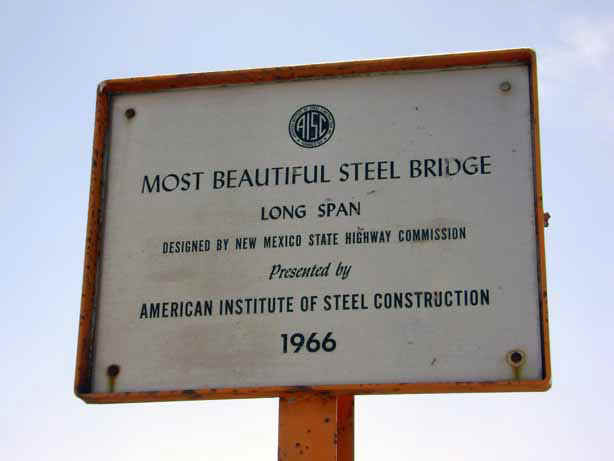 Pueblo
village- one of the oldest communities in the U.S.- it has been inhabited by the native
peoples for over 1,000 years and continues to thrive today. All around are museums,
artists' homes/studios, museums, hiking/biking trails, hot springs, lakes, mountains and
the amazing desert. Pueblo
village- one of the oldest communities in the U.S.- it has been inhabited by the native
peoples for over 1,000 years and continues to thrive today. All around are museums,
artists' homes/studios, museums, hiking/biking trails, hot springs, lakes, mountains and
the amazing desert.
On our ride into Taos, we crossed the Rio Grande Gorge Bridge, the second highest
cantilever bridge in the U.S. It rises 650 feet above 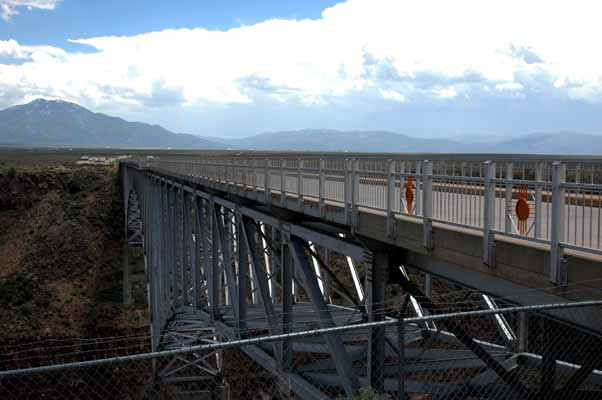 the Rio Grande, and
spans 1,200 feet across. We walked out to the middle to capture the amazing view- an
adventure that is not for the faint of heart, or those afraid of heights. It turns
out that I am both, so we headed back to safety quickly after getting some great shots. the Rio Grande, and
spans 1,200 feet across. We walked out to the middle to capture the amazing view- an
adventure that is not for the faint of heart, or those afraid of heights. It turns
out that I am both, so we headed back to safety quickly after getting some great shots.
We decided to do some camping since it has been a while since our last camping
stint. And wouldn't you know it- the weather had been perfect, right up until we
started to pitch our tent! Then the rains came, and came, and came. And the
thunder, and the lightening. Luckily it did not last through the night, and our
second day in Taos the weather was supreme. We headed out of town to visit the most
photographed church in the south west- the Church of Saint Francis of Assisi. After
a delicious lunch at Ranchos Plaza Restaurant we walked over to the church and, like many
tourists before us, took several pictures of the adobe church which was built in the
1700's. We noticed a congregation all dressed in white circling the outside of the
church. A local man told us they were celebrating the Corpus Christi. This was
a beautiful display, but out of respect, we have no pictures to document it. The
church itself is beautiful, and has inspired such artists as 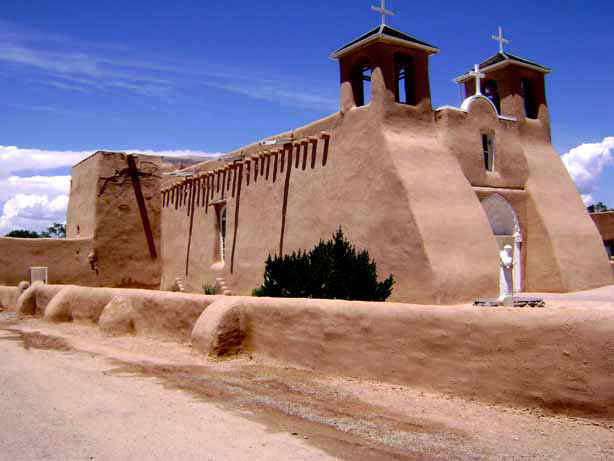 Ansel Adams and Georgia
O'Keefe. The shadows from the huge buttresses that flank the church make it appear
to change with every viewing. Ansel Adams and Georgia
O'Keefe. The shadows from the huge buttresses that flank the church make it appear
to change with every viewing.
Afterwards, we headed out on a scenic drive (listed among the National Geographic's 100
scenic highways and byways) on a loop called the "Enchanted Circle." The
Enchanted Circle is an 84-mile loop with several points of interest, including two ski
areas, a ghost town, Eagle Nest Lake, hiking trails, and several artists' homes and
studios. We got out on the loop a bit too late in the day to g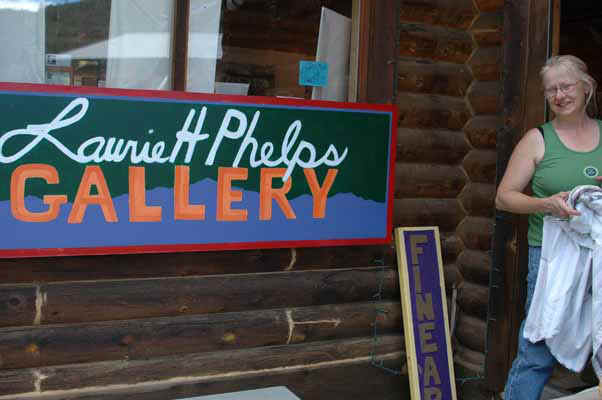 et out and explore
everything, but we did make it to one artist's home/studio- her name is Laurie H.
Phelps. Laurie paints oils, and watercolors and has a unique way of layering the
paint so that it jumps out of the canvas. Some of these paintings take six months to
a year to create. They are vibrantly colorful and so beautiful. Laurie spent
some quality time talking with us about her artistry, her techniques, and generously
allowed us to photograph many of her paintings. We purchased a small, blue water
color of a dragon fly before heading out to see more of the loop. et out and explore
everything, but we did make it to one artist's home/studio- her name is Laurie H.
Phelps. Laurie paints oils, and watercolors and has a unique way of layering the
paint so that it jumps out of the canvas. Some of these paintings take six months to
a year to create. They are vibrantly colorful and so beautiful. Laurie spent
some quality time talking with us about her artistry, her techniques, and generously
allowed us to photograph many of her paintings. We purchased a small, blue water
color of a dragon fly before heading out to see more of the loop.
We made one other stop on our ride around the Enchanted Circle- and that was to the
Vietnam Veteran's National Memorial state park. This was a really amazing memorial-
which included a Vietnam War helicopter, a bronze statue of a soldier, and an indoor photo
gallery and film. 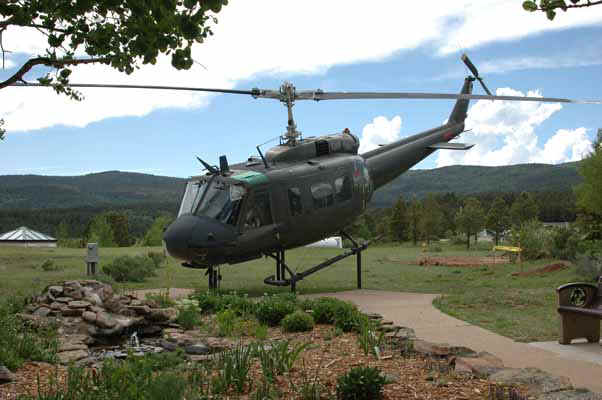 We watched most of the film, "Letters Home From
Vietnam" before the memorial center closed at 5:00 pm. This was an intense and
compelling film which depicts photos of Vietnam soldiers, as well as readings of their
letters home to loved ones. This film comes highly recommended, if you can find it
(it's an HBO film). Personally I think everyone should see it- particularly in light of
the current war we are waging. There seem to be so many parallels between the
Vietnam war and the present one. We watched most of the film, "Letters Home From
Vietnam" before the memorial center closed at 5:00 pm. This was an intense and
compelling film which depicts photos of Vietnam soldiers, as well as readings of their
letters home to loved ones. This film comes highly recommended, if you can find it
(it's an HBO film). Personally I think everyone should see it- particularly in light of
the current war we are waging. There seem to be so many parallels between the
Vietnam war and the present one.
It was getting late, so we completed the rest of the circle and headed back to the
campsite. After a quick cereal dinner, we turned in just after the sun had
set. We continued our reading of The Alchemist by flashlight (yes- we're still
reading it. Turns out we only read this one when we're camping, so we're about half
way through). Tomorrow we are planning to visit the Pueblo village and the downtown
area. We might head to a local pub later in the evening to see a live musician,
Michael Hearne, play guitar. There's still so much to do and see here, so we're not
sure exactly how much longer we'll be staying, but at least another day, if not two!
So far, New Mexico is really interesting and colorful- so enjoy the pictures, and we'll
write more soon. (Since we're outside at our campground and it's about to rain with
ominous thunder blaring it's horns, we'll have to post pictures later.) Bye for
now. ~E
back to top
|
[weeks 1-10]
[weeks 11-20]
week 1 | week 2 | week 3 | week 4 | week 5 | week 6 | week 7 | week 8 | week 9 | week 10 |